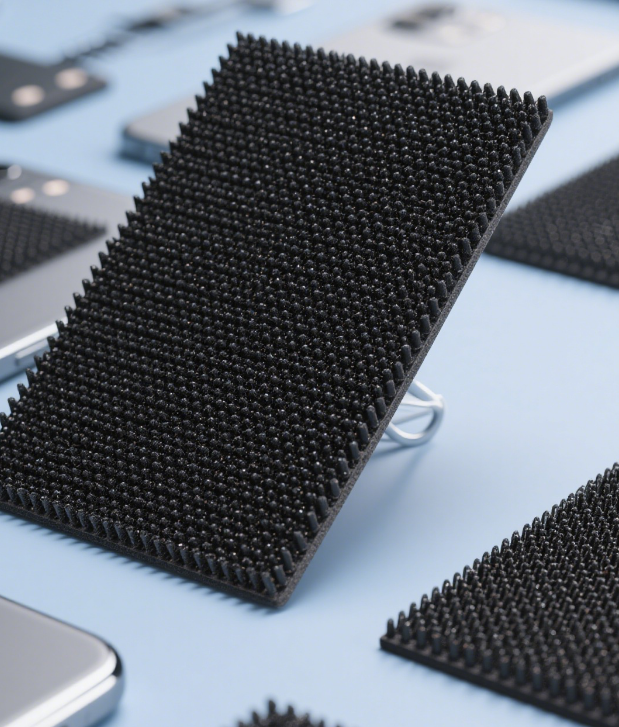Application Fields and Development Prospects of Conductive Elastic Rubber
I. Introduction
Conductive elastic rubber is a functional material that combines electrical conductivity and elasticity. By adding conductive fillers such as carbon black, metal powders, and carbon fibers to the rubber matrix, the rubber acquires electrical conductivity. This unique combination of properties gives it broad application prospects in multiple fields.
II. Application Fields of Conductive Elastic Rubber
(I) Electronic Information Field
Electromagnetic Shielding and Conductive Sealing
In electronic devices, electromagnetic interference (EMI) is a problem that cannot be ignored. It can affect the normal operation of the devices and even pose potential threats to human health. Conductive elastic rubber has good electrical conductivity and elasticity, which can effectively shield electromagnetic signals and prevent the propagation of electromagnetic interference. For example, at the seams of the casings of electronic instruments such as computers, mobile phones, and communication devices, seals made of conductive elastic rubber can achieve good electromagnetic shielding effects, and at the same time, they can also play the roles of waterproofing and dustproofing. In addition, in printed circuit boards (PCBs), conductive elastic rubber can also be used to connect conductive components to ensure the stable transmission of signals.
Flexible Circuits and Sensors
With the development of flexible electronics technology, the application of conductive elastic rubber in the fields of flexible circuits and sensors has received increasing attention. It can be used as a conductive material for flexible circuits to fabricate bendable and foldable circuits, meeting the requirements of electronic devices in various special shapes and complex environments. For example, in wearable devices such as smart bracelets and smart watches, conductive elastic rubber can be used to make flexible electrodes and sensors to achieve real-time monitoring of human physiological signals (such as heart rate, blood pressure, body temperature, etc.). In addition, conductive elastic rubber can also be used to make pressure sensors, strain sensors, etc., which are widely used in industrial automation, robotics, and other fields.
(II) Energy Field
Batteries and Supercapacitors
In batteries and supercapacitors, conductive elastic rubber can be used as an electrode material or a separator material. As an electrode material, it can provide good electrical conductivity and mechanical properties, improving the energy density and cycle life of batteries and supercapacitors. For example, in lithium-ion batteries, mixing conductive elastic rubber with active materials to make electrodes can improve the conductivity and flexibility of the electrodes and reduce the cracking and shedding of the electrodes during the charging and discharging processes. As a separator material, conductive elastic rubber has good insulation and air permeability, which can prevent short circuits between the positive and negative electrodes of the battery and allow ions to pass through at the same time, improving the performance of the battery.
Solar Cells
In solar cells, conductive elastic rubber can be used to make electrodes and packaging materials. As an electrode material, it can effectively collect and transmit the current generated by solar cells, improving the conversion efficiency of solar cells. As a packaging material, conductive elastic rubber has good weather resistance and flexibility, which can protect solar cells from the influence of the external environment and extend the service life of solar cells.
(III) Aerospace and Defense Fields
Aerospace Equipment
In the aerospace field, conductive elastic rubber is mainly used for the electromagnetic shielding, conductive sealing, and thermal management of aircraft, missiles, satellites, and other equipment. For example, at the joints of the fuselage and wings of an aircraft, conductive elastic rubber seals can prevent electromagnetic interference and can also withstand the aerodynamic pressure and temperature changes when the aircraft is flying at high speed. In addition, conductive elastic rubber can also be used to make flexible circuits and sensors in aerospace equipment to meet the requirements of aerospace equipment for lightweight and high reliability.
Defense and Military Industry
In the defense and military industry, conductive elastic rubber can be used to make stealth materials, conductive armor, and electronic countermeasure equipment. As a stealth material, conductive elastic rubber can absorb radar waves, reduce the radar cross-section of the target, and achieve the stealth effect. As conductive armor, it can effectively prevent the attacks of electromagnetic pulses and lightning and protect the electronic systems of weapons and equipment. In electronic countermeasure equipment, conductive elastic rubber can be used to make jamming antennas and signal receiving antennas to improve the performance of electronic countermeasure equipment.
(IV) Automotive Field
Automotive Electronics
In the field of automotive electronics, conductive elastic rubber is mainly used for the electromagnetic shielding, conductive sealing, and sensors of automobiles. For example, in electronic components such as the engine control unit (ECU) and in-vehicle communication equipment of automobiles, conductive elastic rubber seals can prevent electromagnetic interference and ensure the normal operation of the electronic components. In addition, conductive elastic rubber can also be used to make pressure sensors, temperature sensors, etc. of automobiles to achieve real-time monitoring of the running state of the automobiles.
Automotive Interior and Safety
In terms of automotive interior, conductive elastic rubber can be used to make conductive coatings for components such as car seats, steering wheels, and instrument panels to prevent static electricity accumulation and improve the safety and comfort of the automotive interior. In terms of automotive safety, conductive elastic rubber can also be used to make automotive anti-collision sensors and seat belt pretensioners to improve the safety performance of the automobiles.
(V) Medical Field
Medical Equipment and Instruments
In the field of medical equipment and instruments, conductive elastic rubber can be used to make medical electrodes, sensors, and surgical instruments. For example, in medical equipment such as electrocardiographs and electroencephalographs, electrodes made of conductive elastic rubber can make good contact with the human skin, reduce signal interference, and improve the detection accuracy. In addition, conductive elastic rubber can also be used to make electrodes and sensors of implantable medical devices, such as pacemakers and blood glucose sensors, to achieve long-term monitoring and treatment of human internal physiological signals.
Rehabilitation Medicine
In the field of rehabilitation medicine, conductive elastic rubber can be used to make rehabilitation aids and prosthetics. For example, in prosthetics, conductive elastic rubber can be used as sensors and driving components to achieve precise control and perception of the movement of the prosthetics. In addition, conductive elastic rubber can also be used to make pressure sensors and strain sensors of rehabilitation training equipment to help patients with rehabilitation training.
III. Development Prospects of Conductive Elastic Rubber
(I) Technological Development Trends
Combination of High Conductivity and High Elasticity
Currently, there is a certain contradiction between the electrical conductivity and elasticity of conductive elastic rubber. Increasing the conductivity often reduces the elasticity, and vice versa. In the future, it is necessary to further study the types, shapes, sizes, and distribution patterns of conductive fillers, as well as the selection and modification of the rubber matrix, to achieve a good combination of high conductivity and high elasticity.
Multifunctionalization
With the development of science and technology, the performance requirements for conductive elastic rubber are getting higher and higher. It not only needs to have electrical conductivity and elasticity, but also needs to have multifunctional characteristics such as high temperature resistance, low temperature resistance, chemical corrosion resistance, and flame retardancy. In the future, through means such as composite modification and nanotechnology, conductive elastic rubber with multifunctional characteristics will be developed to meet the application requirements of different fields.
Intelligence
Intelligence is an important development direction of materials in the future, and conductive elastic rubber is no exception. By combining conductive elastic rubber with sensors, microprocessors, etc., intelligent conductive elastic rubber materials with functions such as self-perception, self-diagnosis, and self-healing will be developed to achieve real-time response and automatic adjustment to environmental changes.
(II) Market Demand Forecast
With the rapid development of fields such as electronic information, energy, aerospace, automobiles, and medical care, the demand for conductive elastic rubber will continue to increase. It is expected that in the next few years, the global conductive elastic rubber market will maintain a relatively fast growth rate, and the market size will continue to expand. Especially in emerging fields such as wearable devices, new energy vehicles, and smart homes, the application prospects of conductive elastic rubber will be even broader.
(III) Challenges and Countermeasures
Cost Issue
Currently, the cost of conductive elastic rubber is relatively high, mainly due to the high price of conductive fillers. In the future, it is necessary to reduce the cost of conductive elastic rubber and improve its market competitiveness by optimizing the production process, reducing the amount of conductive fillers used, and developing new types of conductive fillers.
Environmental Friendliness
With the increasing awareness of environmental protection, the requirements for the environmental friendliness of conductive elastic rubber are also getting higher and higher. In the future, it is necessary to develop environmentally friendly conductive elastic rubber materials that are lead-free, cadmium-free, and halogen-free to reduce environmental pollution.
Performance Stability
During long-term use, conductive elastic rubber may be affected by environmental factors such as temperature, humidity, and ultraviolet rays, resulting in a decline in performance. In the future, it is necessary to strengthen the research on the performance stability of conductive elastic rubber and develop conductive elastic rubber materials with good weather resistance and aging resistance.
IV. Conclusion
As a functional material that combines electrical conductivity and elasticity, conductive elastic rubber has broad application prospects in fields such as electronic information, energy, aerospace, automobiles, and medical care. With the continuous development of technology and the increasing market demand, conductive elastic rubber will develop in the direction of high conductivity, high elasticity, multifunctionalization, and intelligence. At the same time, it also faces challenges in terms of cost, environmental friendliness, and performance stability. In the future, it is necessary to strengthen technological research and development to solve these problems and promote the healthy development of the conductive elastic rubber industry.
















